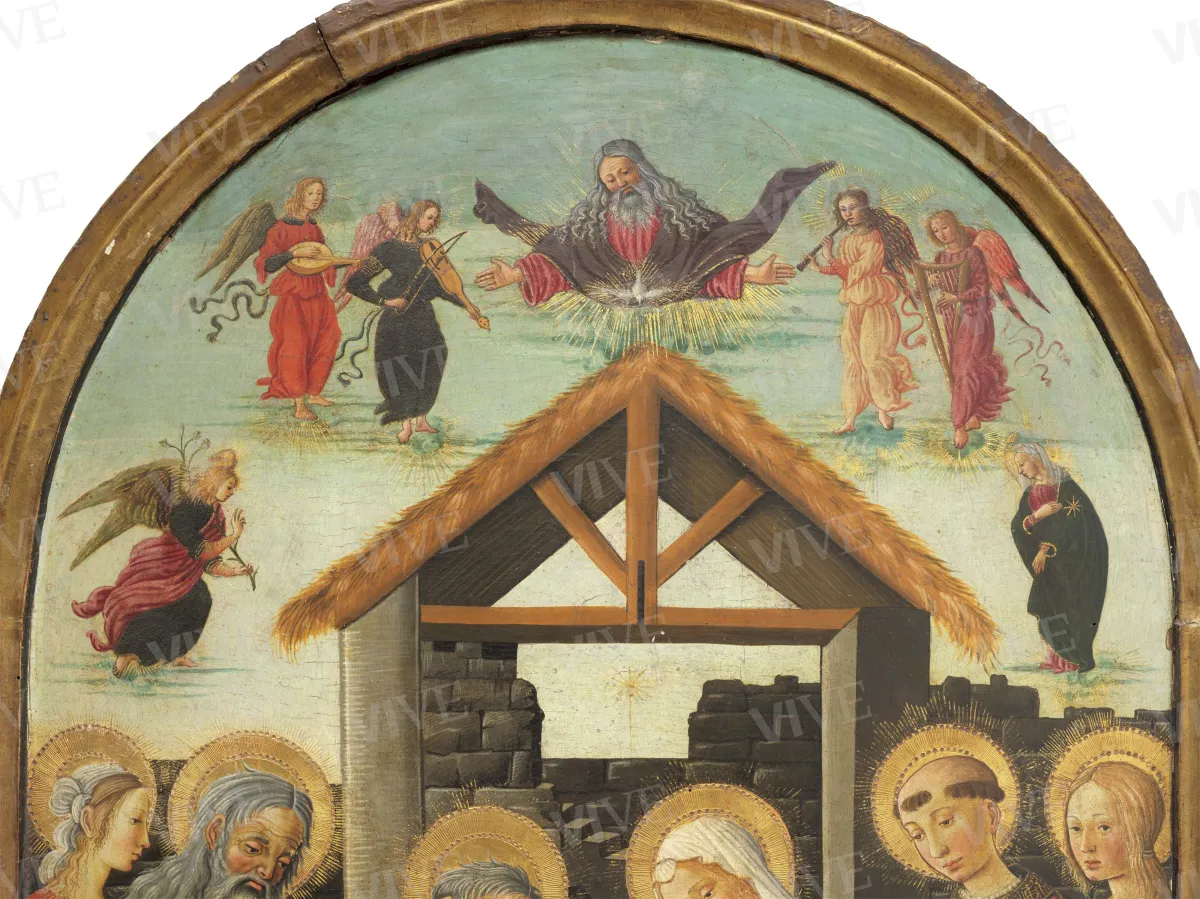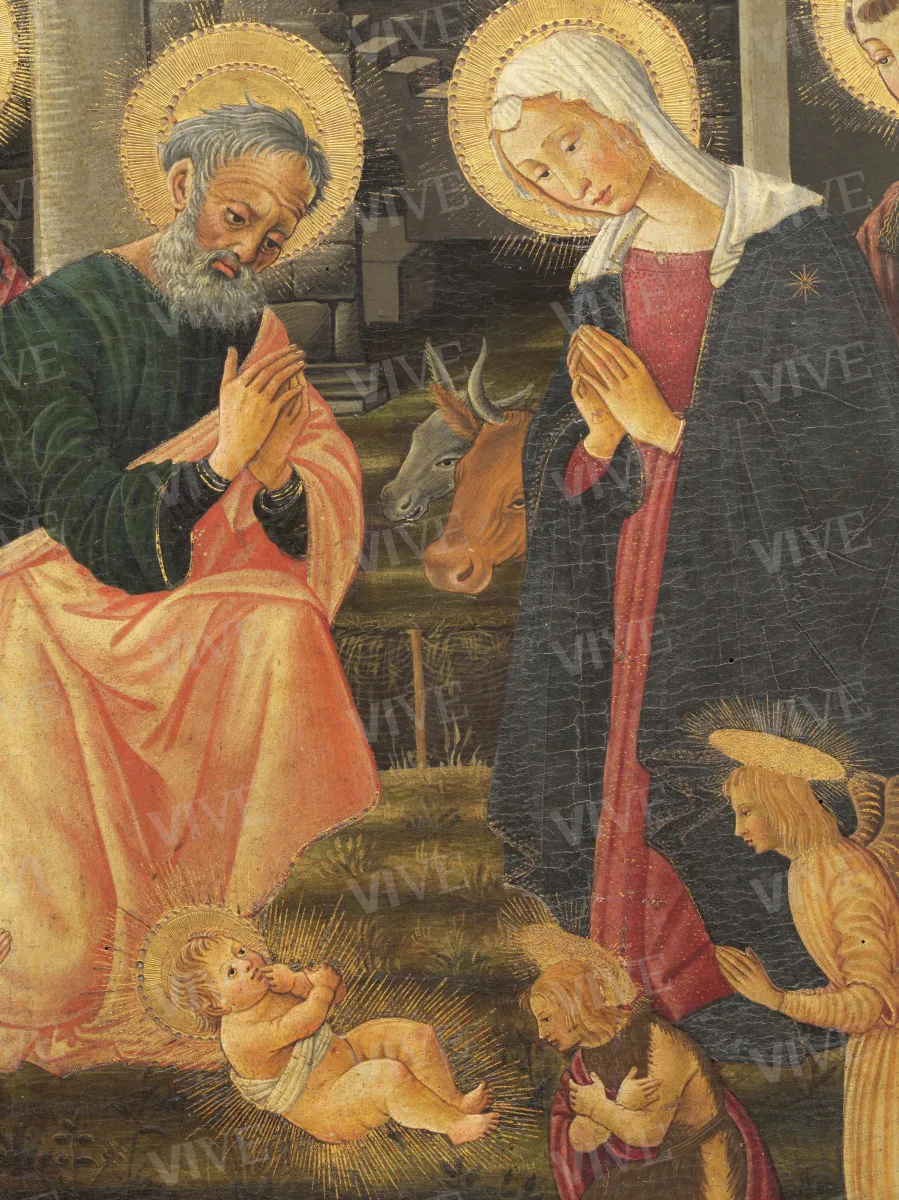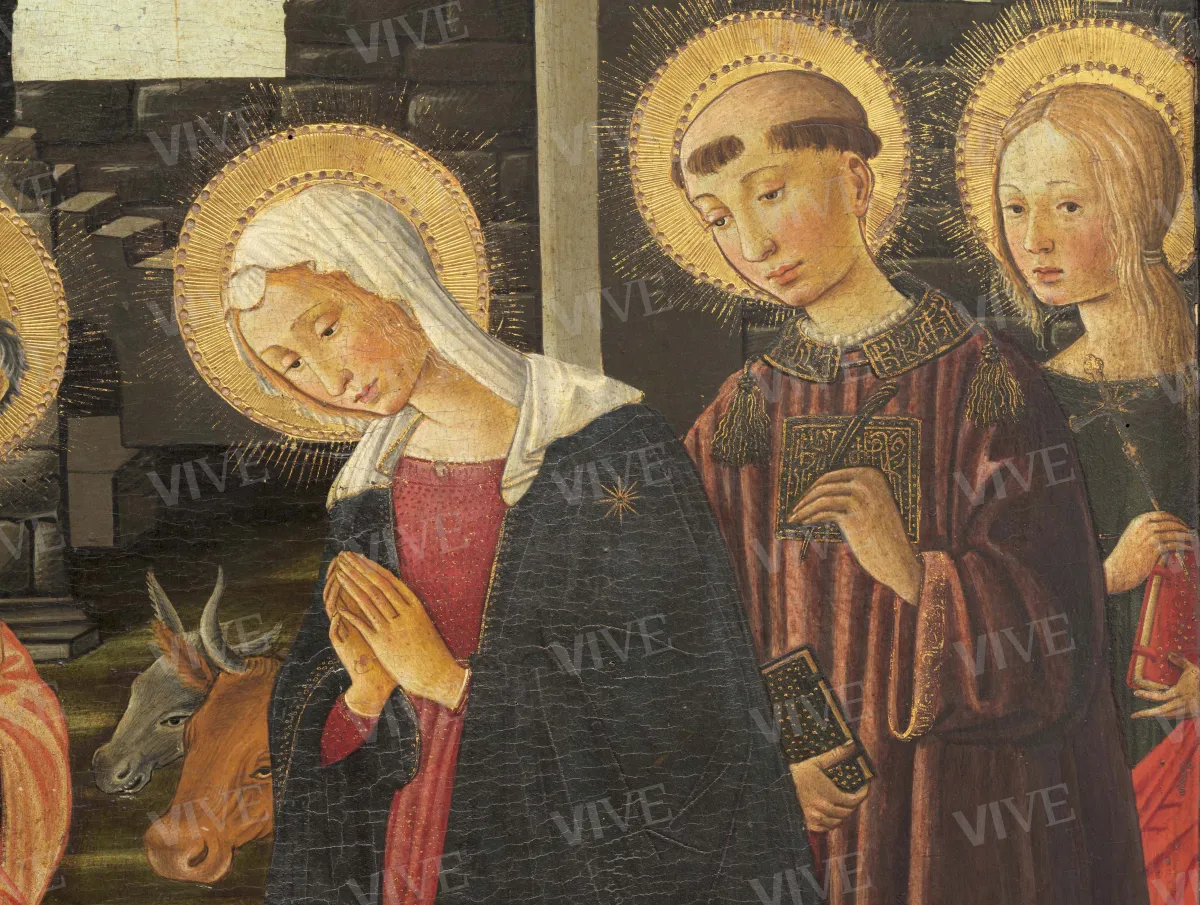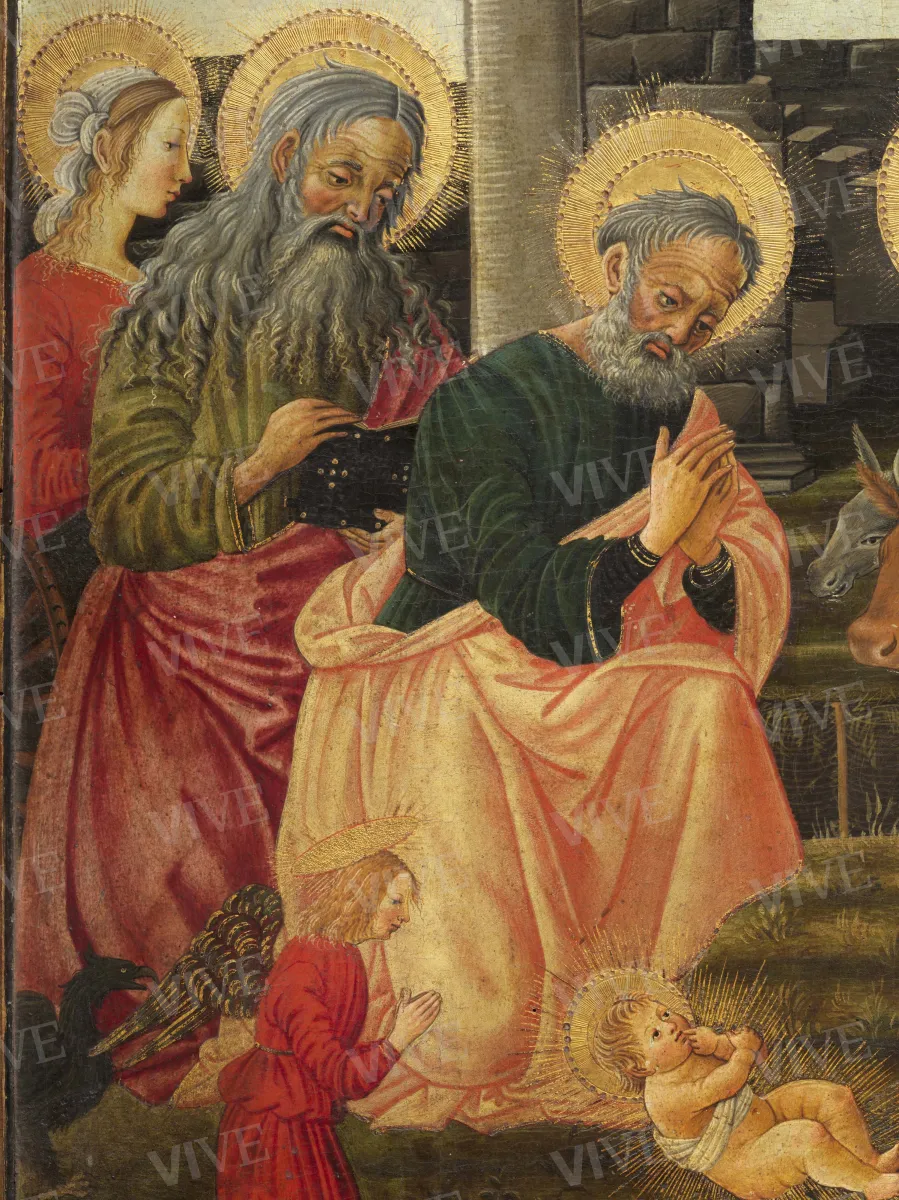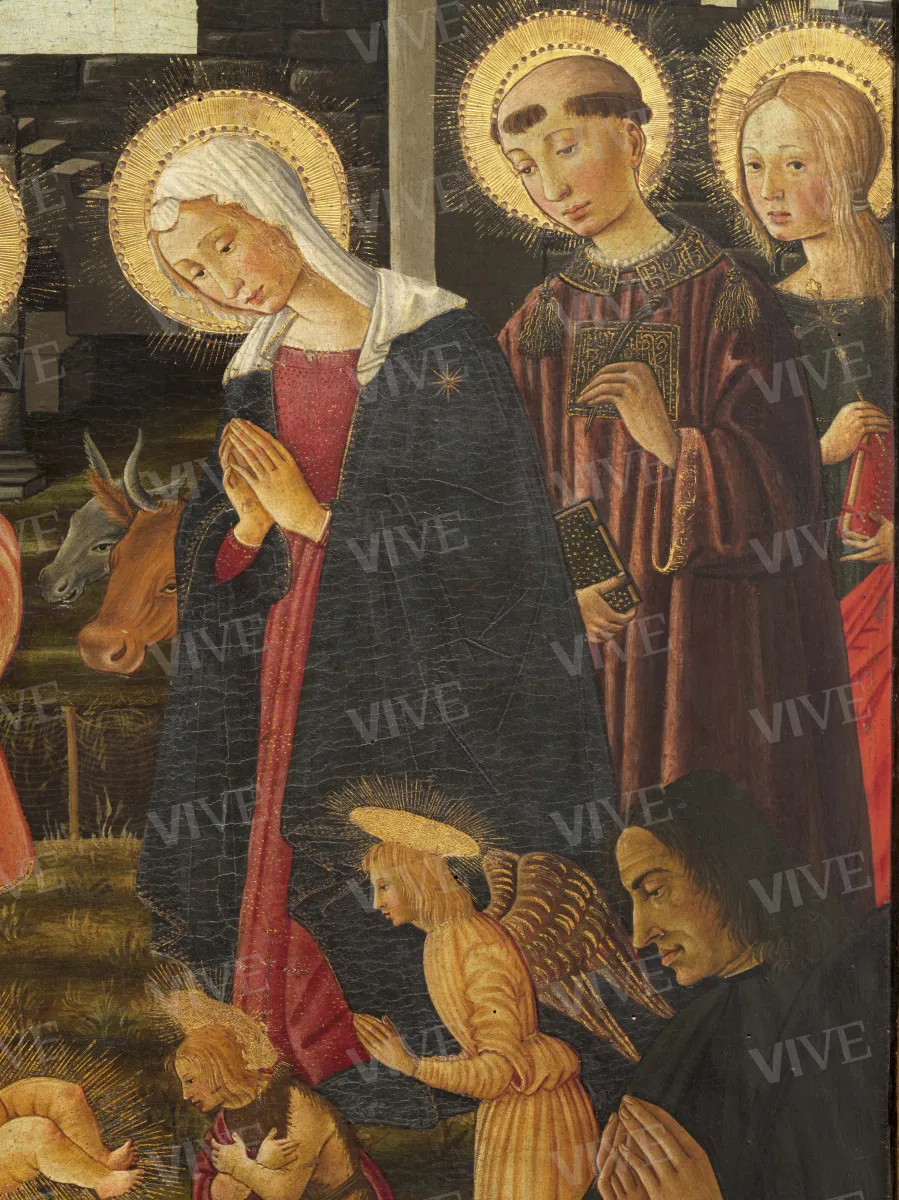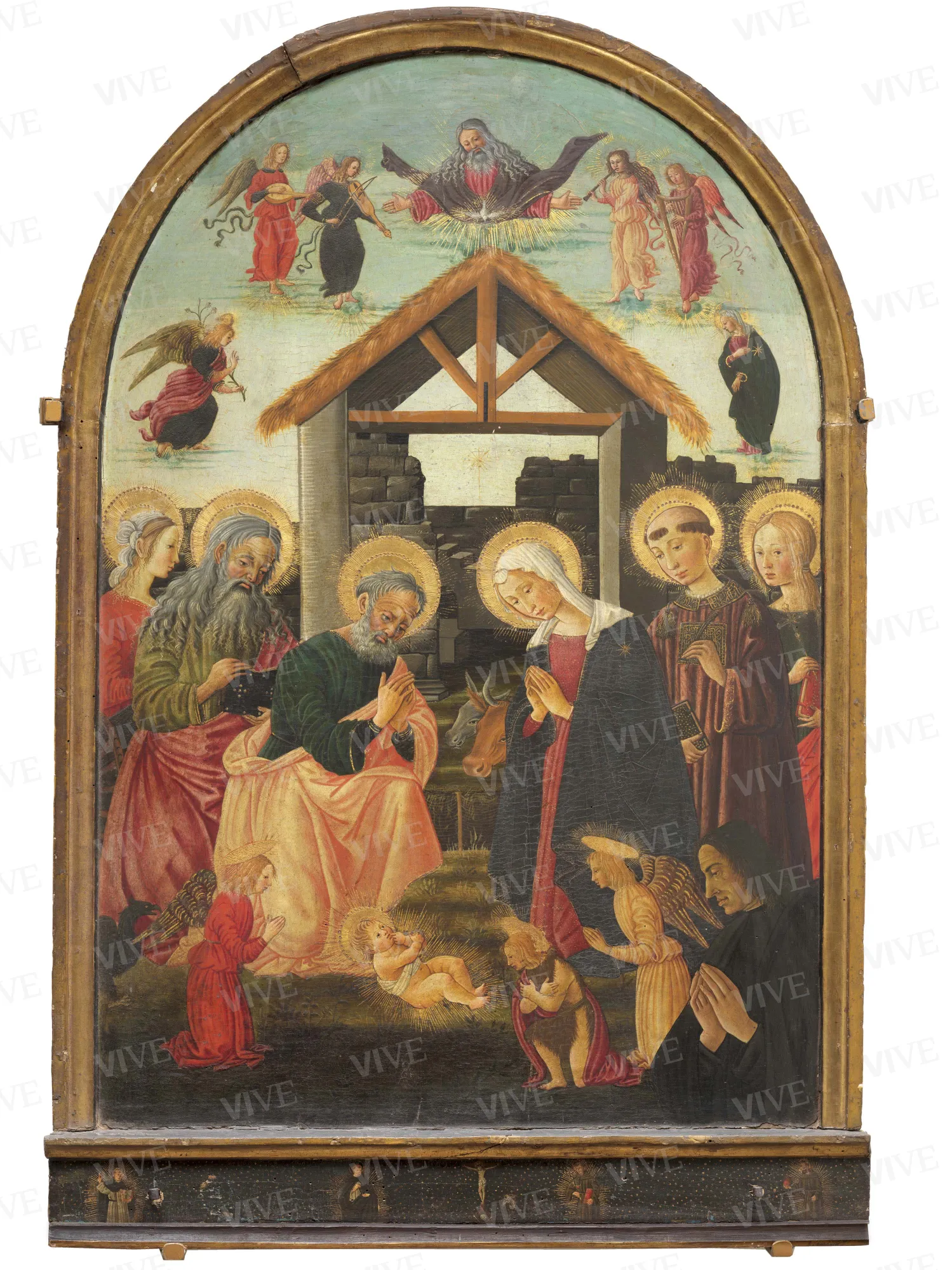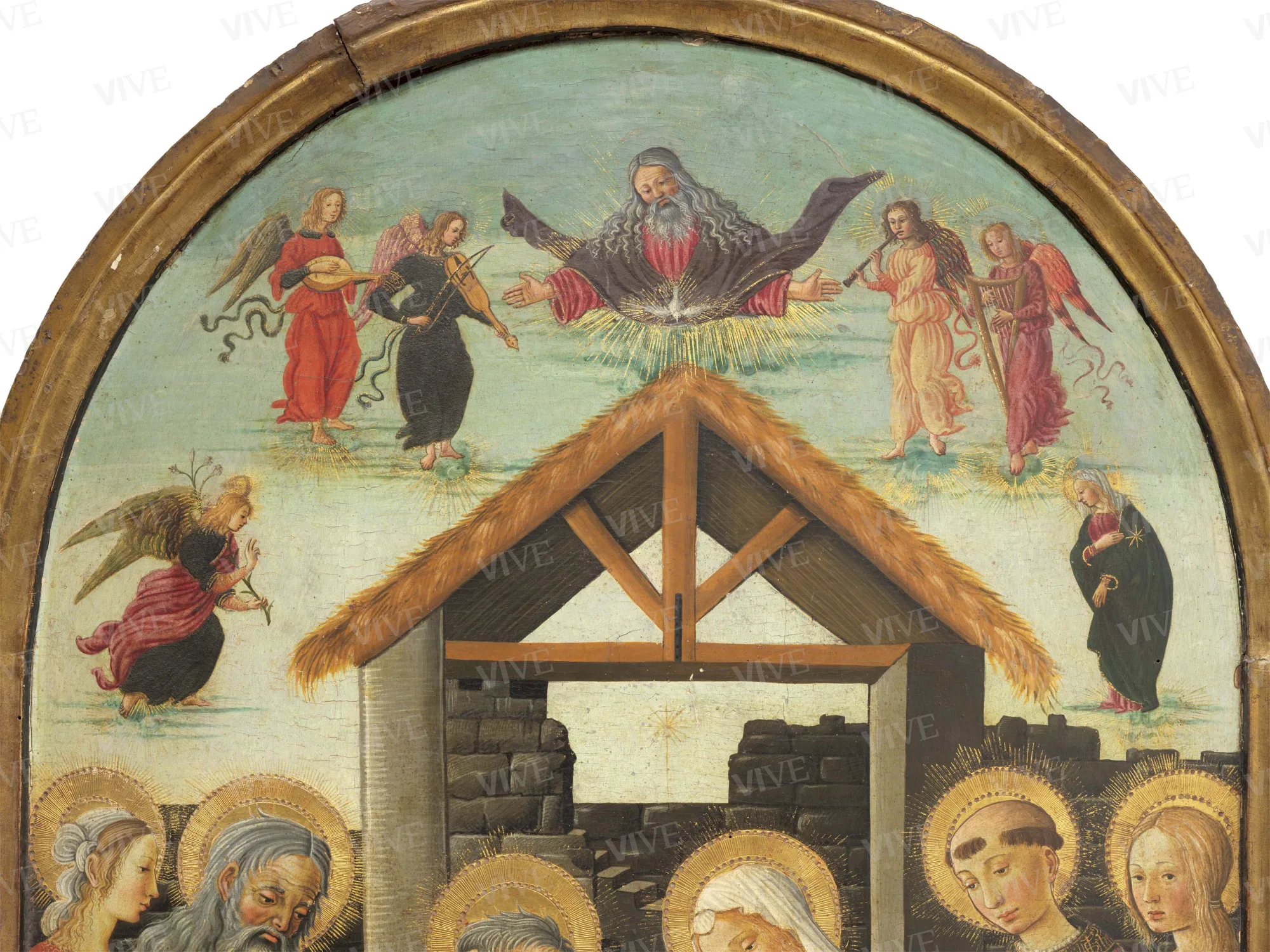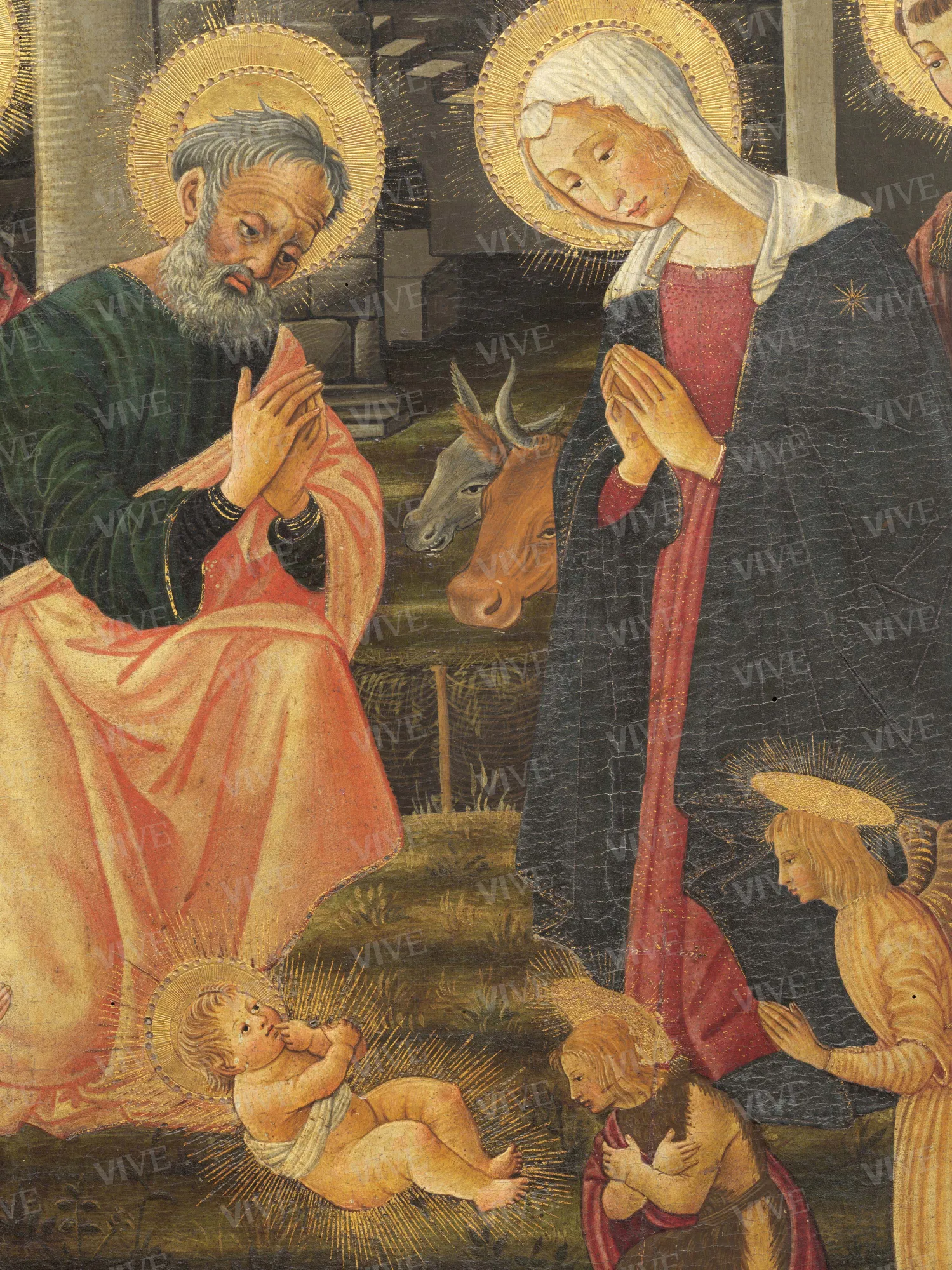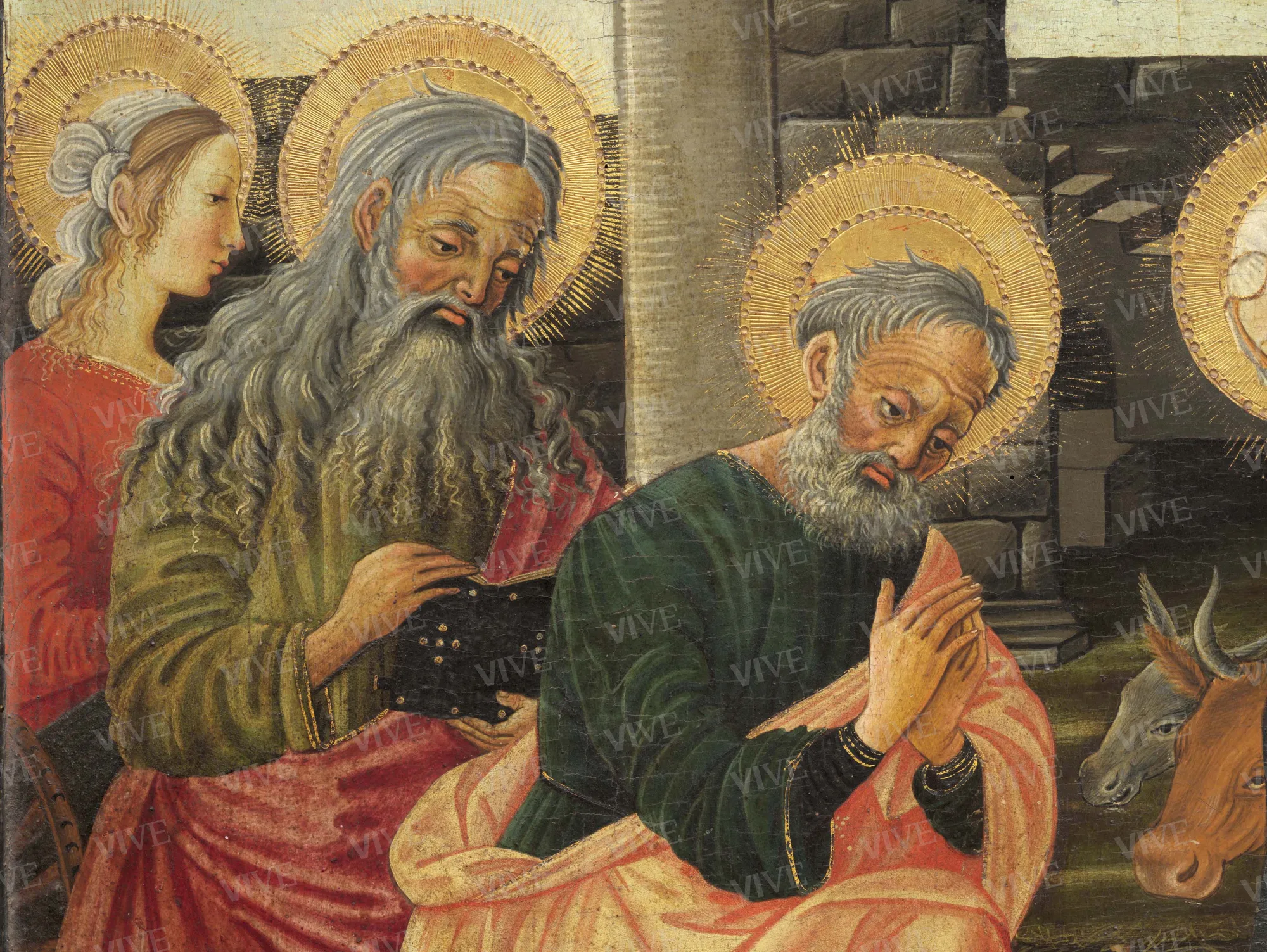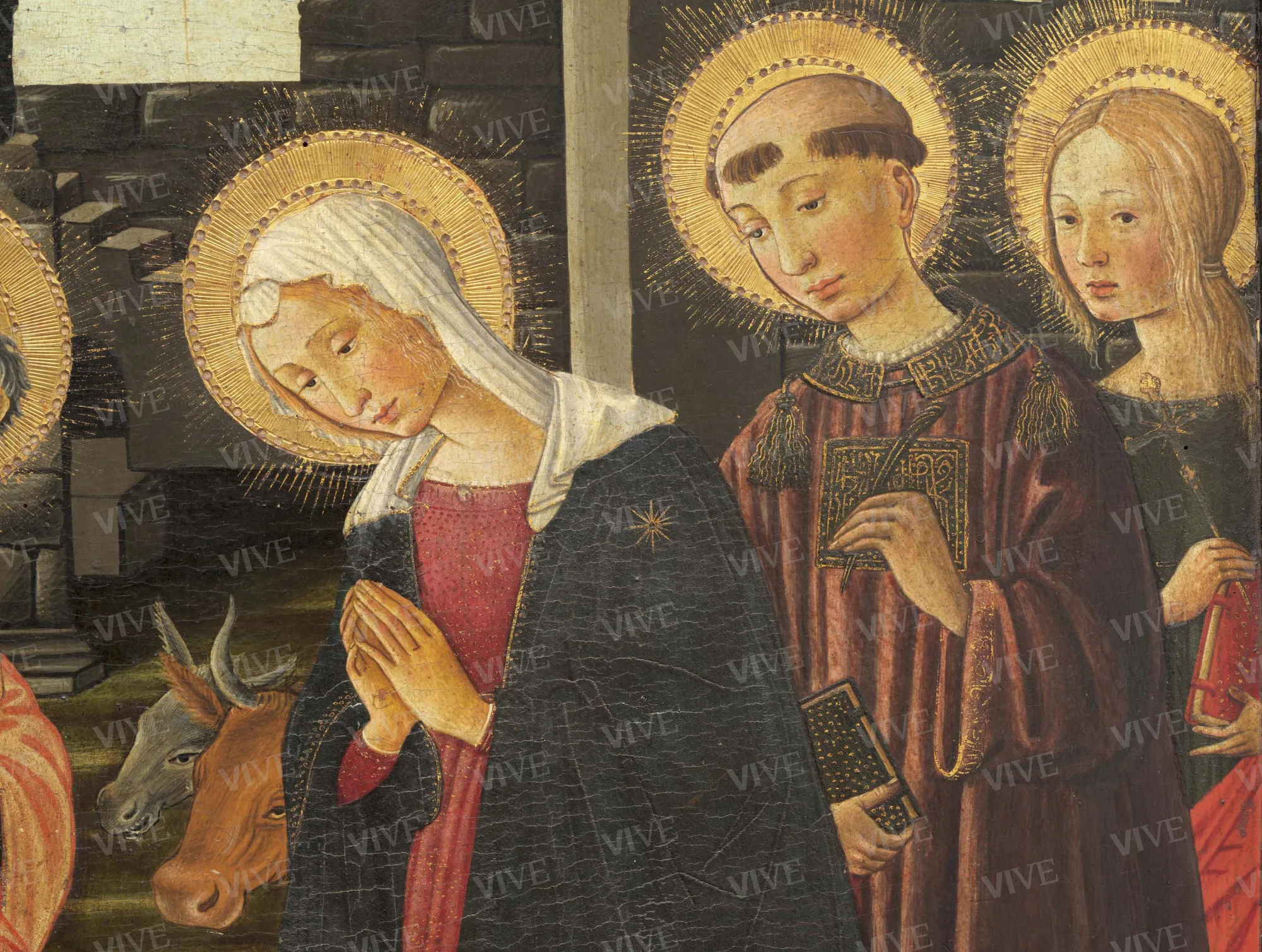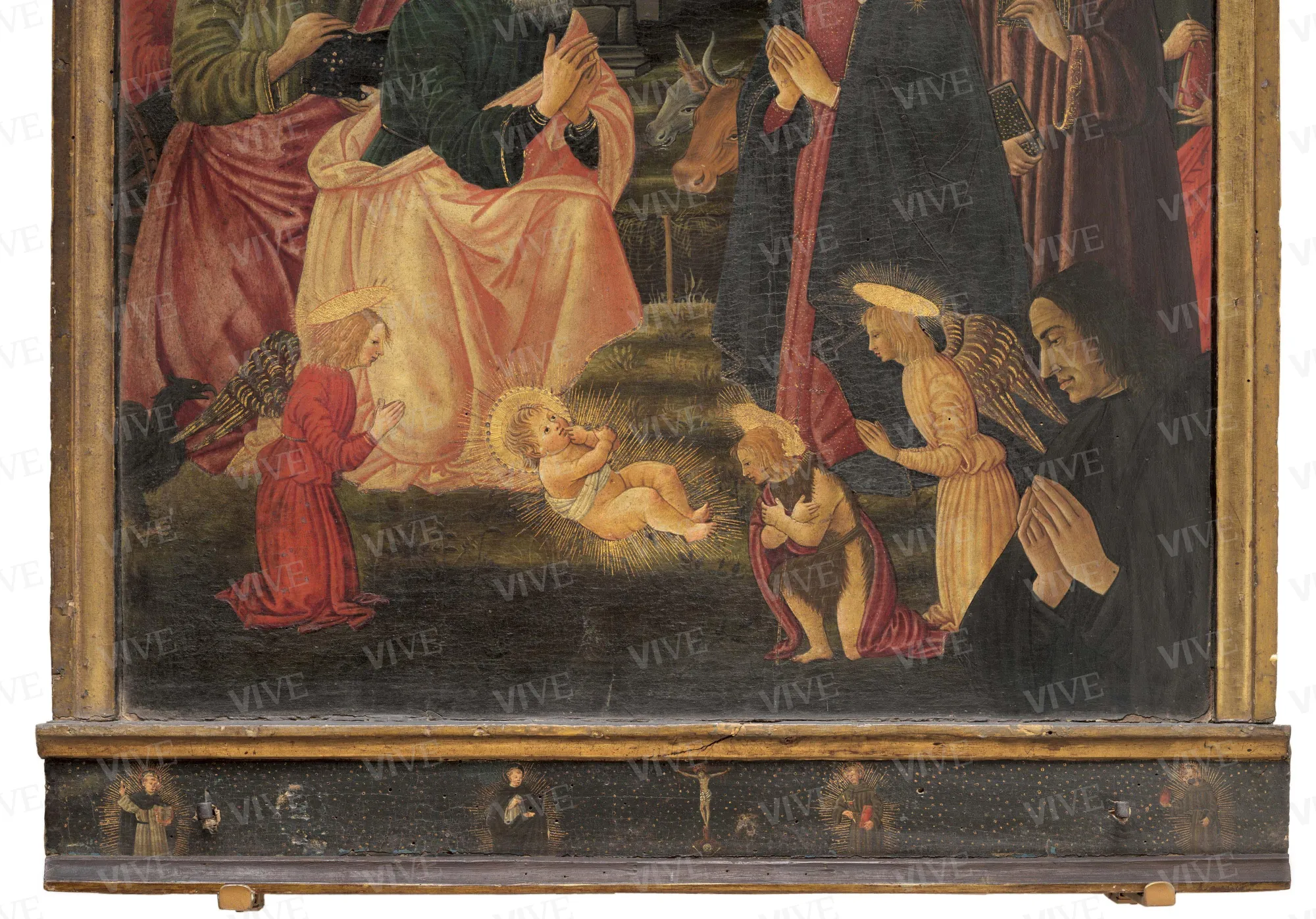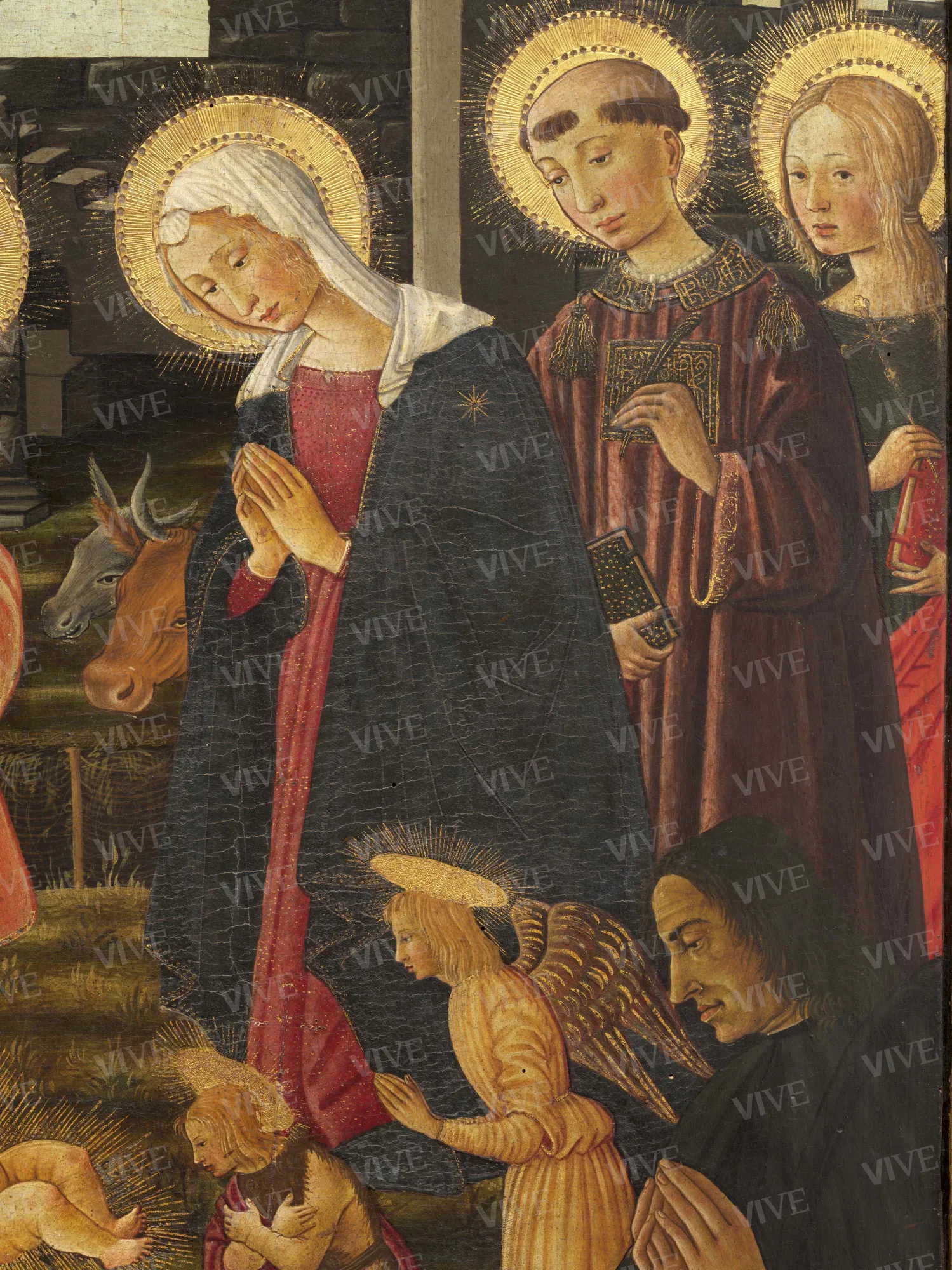Adoration of the Child with Saints and Donor
Master of the Wurts Adoration Last quarter of fifteenth century
This Adoration of the Child with Angels and Saints constitutes one of the most interesting works within a large group of paintings that, still several years later, refer to the models of Pesellino and Filippo Lippi. The author, who still remains unknown and to whom we have chosen to give a conventional name, shows a desire to keep up to date with the most recent models by Filippino and Botticelli. The lively and articulate narrative, embellished with fine gold details, suggests a rather important patron, for whom the prestigious name of Lorenzo the Magnificent has been proposed.
This Adoration of the Child with Angels and Saints constitutes one of the most interesting works within a large group of paintings that, still several years later, refer to the models of Pesellino and Filippo Lippi. The author, who still remains unknown and to whom we have chosen to give a conventional name, shows a desire to keep up to date with the most recent models by Filippino and Botticelli. The lively and articulate narrative, embellished with fine gold details, suggests a rather important patron, for whom the prestigious name of Lorenzo the Magnificent has been proposed.
Details of work
Catalog entry
In the main, cambered panel, Joseph and Mary kneel in front of the hut, praying towards the Child lying on the ground in the center. They are accompanied, to the left, by Saint Catherine of Alexandria and Saint John the Evangelist and, to the right, by Saint Lawrence and a saint holding a small cross and a book, possibly Saint Mary Magdalene. On either side of the Child are two kneeling angels, with Saint John and the patron, who is looking down with his hands clasped in prayer. Above, God the Father and the dove representing the Holy Ghost are surrounded by musician angels, with the Annunciation depicted below them. In the predella, four saints of the Dominican and Franciscan order flank the figure of the crucified Christ.
The painting was first referenced in the sales catalogue of Robert J. Nevin’s collection in 1907 (Mason Perkins 1907, p. 16, no. 58; Minardi 2017, pp. 177–187). Subsequently, it came into the possession of George Washington Wurts and Henriette Tower, with the latter donating it to the Museo di Palazzo Venezia in 1933 along with her entire collection (Minardi 2017, p. 200; Fachechi 2017, pp. 111–121). The attributional complexities surrounding the painting have served as a notable case study for some of the foremost art experts of the twentieth century.
In the sale catalog of the Nevin collection, the artwork was labeled as 'Florentine School' (Mason Perkins 1907, p. 16, no. 58). Upon its acquisition by Palazzo Venezia, Federico Zeri attributed it to Pseudo Pier Francesco Fiorentino (Zeri 1955, p. 8, no. 87), an artist whose style closely mirrored that of Pier Francesco Fiorentino yet remained distinct. This identification and nomenclature were established by Frederick Mason Perkins (1928, pp. 188–189) and Bernard Berenson (1932, pp. 449–452). While Pier Francesco di Bartolomeo, known as Pier Francesco Fiorentino, was notably influenced by Benozzo Gozzoli (Bernacchioni 2015, p. 318; Bagnoli 2019, pp. 129–152), Pseudo Pier Francesco Fiorentino seemed to develop within the circles of Filippo Lippi and Pesellino, often emulating their models.
Zeri later more cautiously categorized the group of paintings previously attributed to Pseudo Pier Francesco Fiorentino under the heading “Imitators of Filippo Lippi and Pesellino” (Zeri 1958, p. 18; Zeri 1971, p. 106; Zeri 1976, pp. 80–81). It has also been suggested that these works could be associated with the painter Piero di Lorenzo Pratese, identified by Ugo Procacci as the last heir of Pesellino’s workshop (Procacci 1961; Bernacchioni 1992, pp. 160–161; Strehlke 2004, pp. 367–368; Fahy 2020, p. 344) or Riccardo di Benedetto di Niccolò, known as “Riccardo delle nostre donne” (or, Riccardo of our women) (Gilbert 1988, pp. 202–205; De Marchi 2022, p. 6; Civettini 2022, p. 27).
In the extensive catalogue of “Imitators of Filippo Lippi and Pesellino,” Mauro Minardi (2017, pp. 200–201) has recently aimed to identify a specific artist, whose most notable work is the panel in the Palazzo Venezia. This painter has been designated as the Master of the Wurts Adoration.
The connections with the core works attributed to the so-called Pseudo Pier Francesco are particularly evident in the depiction of the Virgin, characterized by her facial features framed by a veil and the distinctive position of her hands in prayer. The painting employs a well-defined outline and a light, colored chiaroscuro aimed more at achieving delicate and precious effects than at exploring depth. The depiction of God the Father with outstretched arms and mantle flaps lifting at his sides is inspired by Filippo Lippi’s renowned painting for the chapel of the Magi in the Palazzo Medici Riccardi, now housed in the Gemäldegalerie in Berlin. The painter’s attention to artists of a subsequent generation, such as Jacopo del Sellaio, Botticelli, or Filippino (Minardi 2017, pp. 200–201; Civettini 2022, p. 39), suggests dating the work to the last quarter of the fifteenth century. Although the painting does not reach the heights of Florentine art in the late fifteenth century, the artist’s effort to compose a highly detailed narrative within a modestly sized panel, enriched with precious gold details, is noteworthy. Given the portrait of the patron beneath Saint Lawrence (San Lorenzo in Italian) bears a strong resemblance to known portraits of Lorenzo de’ Medici, it has been tentatively suggested, though not proven, that the work was commissioned by Lorenzo de’ Medici himself (Acidini Luchinat 1991, pp. 127–128; De Marchi 2022, p. 6).
Francesca Mari
Entry published on 27 March 2025
State of conservation
Good.
Inscriptions
On the verso: “Sale of the Rev. R.I. Nevin / Rome. April 1907 / n. 58 Florentine school / Last half of the fifteenth century / The adoration of the child with several / saints and angels and the donor. On panel / 2000 + 100 Lire.”
Provenance
Rome, Robert J. Nevin collection, documented in 1907;
Rome, Palazzo Antici Mattei, George Washington Wurts and Henrietta Tower collection;
Rome, Museo di Palazzo Venezia, Wurts donation, 1933.
Exhibition history
Rome, Museo Nazionale di Palazzo Venezia, Voglia d’Italia. Il collezionismo internazionale nella Roma del Vittoriano, December 7, 2017–March 4, 2018.
References
Mason Perkins Frederick, Galleria della vendita della collezione del fu Reverendo Dottor Roberto I. Nevin, Roma 1907, p. 16, n. 58;
Mason Perkins Frederick, Nuovi appunti sulla Galleria Belle Arti di Siena, in «La Balzana», II, 1928 pp. 183-203;
Berenson Bernard, Italian Picture of the Renaissance, Oxford 1932;
Hermanin Federico, Il Palazzo di Venezia, Roma 1948, p. 213;
Zeri Federico (a cura di), Catalogo del Gabinetto Fotografico Nazionale. 3. I dipinti del Museo di Palazzo Venezia in Roma, Roma 1955, p. 8, n. 87;
Zeri Federico, Un riflesso di Antonello a Firenze, in «Paragone. Arte», 99, 1958, pp. 16-21;
Procacci Ugo, Di Jacopo d’Antonio e delle compagnie di pittori del Corso degli Adimari, in «Rivista d’arte», 35, 1961, pp. 3-70;
Zeri Federico, Italian Paintings. A Catalogue of the Collection of the Metropolitan Museum of Art, New York 1971;
Zeri Federico, Italian Paintings in the Walter Art Gallery, Baltimore 1976;
Gilbert Creighton E., L’arte del Quattrocento nelle testimonianze coeve, Firenze-Vienna 1988;
Acidini Luchinat Cristina, L’immagine medicea: i ritratti, i patroni, l’araldica, le divise, in Borsi Franco (a cura di), "Per bellezza, per studio, per piacere". Lorenzo il Magnifico e gli spazi dell’arte, Firenze 1991, pp. 125-142;
Bernacchioni, in Mina Gregori, Paolucci Antonio, Acidini Luchinat Cristina (a cura di), Maestri e botteghe. Pittura a Firenze alla fine del Quattrocento, catalogo della mostra (Firenze, Palazzo Strozzi, 16 ottobre 1992-10 gennaio 1993), Cinisello Balsamo 1992, pp. 160-161, nn. 5.3, 5.4;
Strehlke Carl Brandon, Italian Paintings, 1250-1450, in the John G. Johnson Collection and the Philadelphia Museum of Art, Philadelphia 2004;
Pittiglio, in Barberini Maria Giulia, Sconci Maria Selene (a cura di), Guida al Museo Nazionale di Palazzo Venezia, Roma 2009, p. 30, n. 16;
Fachechi Grazia Maria, George Washington Wurts, Henriette Tower, una collezione di “curiosità e opere d’arte” e una “magnificent, the handomest ever bestowed on Rome”, in Perini Folesani Giovanna, Ambrosini Massari Anna Maria (a cura di), Riflessi del collezionismo, tra bilanci critici e nuovi contributi, Atti del convegno (Urbino, Palazzo Albani, 3-5 ottobre 2013), Firenze 2014, pp. 339-357;
Bernacchioni Annamaria, Pier Francesco Fiorentino, ad vocem, in Dizionario Biografico degli Italiani, 83, Roma 2015, pp. 318;
Minardi, in Pellegrini Emanuele (a cura di), Voglia d’Italia. Il collezionismo internazionale nella Roma del Vittoriano, catalogo della mostra (Roma, Museo Nazionale di Palazzo Venezia, 7 dicembre 2017-4 marzo 2018), Napoli 2017, pp. 200-201, n. 3.5;
Bagnoli Alessandro, Una pala all’antica in muratura e ad affresco del fiorentino Francesco di Bartolomeo, in Merli Rossella (a cura di), Pian de’ Campi a Poggibonsi, Badesse, Monteriggioni 2019, pp. 129-152;
Fahy Everett, Early Italian Paintings in Washington and Philadelphia [Review], in De Marchi Andrea, Sambo Elisabetta, Everett Fahy (a cura di), Studi sulla pittura toscana del Rinascimento, I, Roma 2020, pp. 339-346;
Civettini Davide, "Stachanovista" e "pasticheur" della pittura fiorentina: lo "Pseudo Pier Francesco Fiorentino", in De Marchi Andrea, Civettini Davide (a cura di), Pseudo Pier Francesco Fiorentino, Firenze 2022, pp. 36, 39;
Daly Christopher, Lista di opere attribuibili allo "Pseudo Pier Francesco Fiorentino" e bottega, in De Marchi Andrea, Civettini Davide (a cura di), Pseudo Pier Francesco Fiorentino, Firenze 2022, p. 45;
De Marchi Andrea, Squisiti arcaismi. La "pittura senza tempo" dello Pseudo Pier Francesco Fiorentino e un Cristo di dolori filippinesco, in De Marchi Andrea, Civettini Davide, Pseudo Pier Francesco Fiorentino. Cristo di dolori, Firenze 2022, p. 6.


